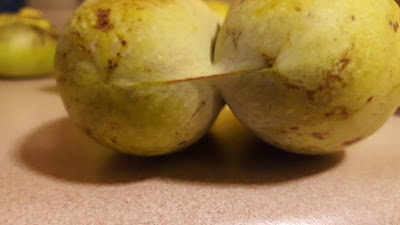| Each pawpaw fruit is born from a flower that has the potential to produce up to about eight fruit at a time, so you'll often see pawpaws growing in clusters. Sometimes the clusters have complications. As they grow in close quarters from the same flower, one fruit might adhere to another fruit, and then the fruit to which it adheres will out pace it in growth, breaking the smaller fruit off of the stem and leaving it like a parasite, hanging onto the larger fruit and then shriveling up eventually. You can see this is what happened with the big pawpaw in the foreground here. The brown nub on top is the smaller fruit in the scenario I've just described. |















No comments:
Post a Comment